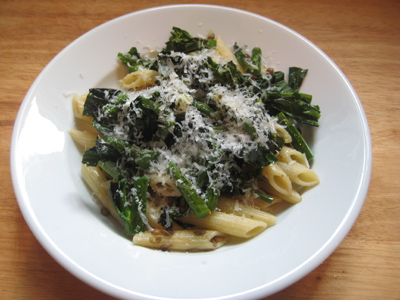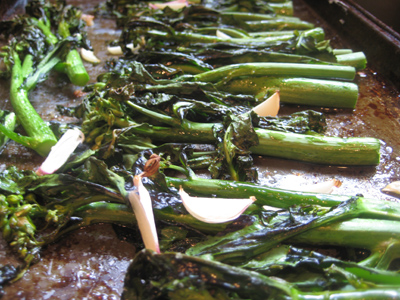 Broccoli rabe, also known as rapini, is one of those vegetables people seem wary of cooking at home. Whenever I buy a bushel, it seems there's always someone standing next to me asking what it is and how I'll cook it. They usually have a curious yet skeptical look on their face, as if to say "that looks mildly interesting, but I'm sticking with the chard." If you only shop in a grocery store, you may never have even seen it for sale as it's mostly available at farmers' markets and Asian produce stores. But if you find yourself in one of those places, I highly recommend buying a batch. Just look for the plant with dark spiky green leaves, small florets (often with tiny white flowers) and medium-sized stalks. It looks a bit like a dandelion greens / broccoli hybrid.
Broccoli rabe, also known as rapini, is one of those vegetables people seem wary of cooking at home. Whenever I buy a bushel, it seems there's always someone standing next to me asking what it is and how I'll cook it. They usually have a curious yet skeptical look on their face, as if to say "that looks mildly interesting, but I'm sticking with the chard." If you only shop in a grocery store, you may never have even seen it for sale as it's mostly available at farmers' markets and Asian produce stores. But if you find yourself in one of those places, I highly recommend buying a batch. Just look for the plant with dark spiky green leaves, small florets (often with tiny white flowers) and medium-sized stalks. It looks a bit like a dandelion greens / broccoli hybrid.
The thing is, broccoli rabe really is worth trying. In addition to it being highly nutritious (it's full of calcium and iron, not to mention Vitamins A and C), its flavors are more complex than other greens. It pairs beautifully with beans, pork and chicken and works well as a side dish or in pasta dishes and soups. It is also one of my favorite foods to serve with Italian sausage. And, if trying new flavors isn't enough, it's one of the cheapest vegetables you can buy. At about $1 a bushel, it's the perfect ingredient if you're looking to make inexpensive family meals.
Broccoli rabe is a staple in both Southern Italian and Chinese cooking. I actually buy mine at the Asian produce stand at my local farmers' market where it sits right next to some long tubers I am very curious about. Some people don't like rapini because it has a pungent smell, but if you don't overcook it, the smell seems more earthy and green, which I like. It is great steamed and sautéed, but I think it tastes best roasted in the oven.

Roasting broccoli rabe in olive oil is the easiest path to rapini success. The hot oven helps tenderize the stalks and crisps up the leaves, so there's no chance of ending up with limp greens. The dry heat also brings out a delicious innate sweetness and removes some of the plant's bitter element. Although many cooks like to blanch the rapini and then sauté it, if you're not careful this method can make the broccoli rabe soggy or droopy. If you don't want to turn on your oven, that's okay too: you can easily get similar results by firing up a hot pan, and sautéing the rapini in olive oil on a high flame with sea salt. Once it sears a bit, just lower the flame, add a couple of tablespoons of water (pasta water is great if you have some on hand) and cover for a couple of minutes.